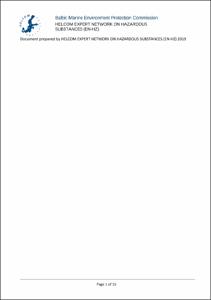| dc.coverage.spatial | Baltic Sea | en_US |
| dc.date.accessioned | 2022-07-18T19:33:18Z | |
| dc.date.available | 2022-07-18T19:33:18Z | |
| dc.date.issued | 2021 | |
| dc.identifier.citation | HELCOM (2021) Technical annex on the determination of Per- and polyfluoroalkyl substances (PFASs) in biota. Helsinki, Finland, HELCOM, 15pp. DOI: http://dx.doi.org/10.25607/OBP-1816 | en_US |
| dc.identifier.uri | https://repository.oceanbestpractices.org/handle/11329/2022 | |
| dc.identifier.uri | http://dx.doi.org/10.25607/OBP-1817 | |
| dc.description.abstract | (PFAAs) are global environmental contaminants. PFOS and PFOA are chemically and biologically inert and very stable (Poulsen et al. 2005). PFOS meets the P (Persistent) and vP (very Persistent) criteria due to slow degradation. PFOS is also bioaccumulative (B) and toxic (T) (OSPAR 2005). PFOA is considered very persistent (vP) and toxic (T) (Van der Putte et al. 2010). PFOA also has the capacity to undergo long-range transportation.
Per- and polyfluoroalkylsubstances (PFAS) can bind to serum albumin and accumulate in blood and organs (Jones et al., 2003). Accumulation in the marine food web starts from the bottom of the food chain, with invertebrates such as zooplankton and molluscs, followed by crustaceans, and then fish (Van de Vijver et al., 2003). The highest PFAS concentrations have been found in blood and internal organs (e.g. liver, kidney) of top predators, such as marine mammals (Martin et al., 2004; Ahrens et al., 2009) and fish‐eating birds (Kannan et al., 2001). Fish species widely used for monitoring of organic contaminants are also suitable for PFAS analysis. Based on the literature, liver is the first choice of tissue for monitoring purposes but PFAS has also been detected in other organs (e.g. blood and muscle at lower concentrations) (Ahrens et al., 2010).
The following guideline focuses on the sampling and extraction of PFASs from biota and address the special aspects of the sampling matrix and is based on a previous ICES guideline for PFAS analysis in biota (Ahrens et al., 2010). It also provides advice for the analysis of PFASs in biota which includes the following steps:
• sampling and tissue selection;
• pretreatment;
• analytical determination. | en_US |
| dc.language.iso | en | en_US |
| dc.publisher | HELCOM | en_US |
| dc.subject.other | Sampling | en_US |
| dc.subject.other | Monitoring | en_US |
| dc.subject.other | Hazardous substances | en_US |
| dc.title | Technical annex on the determination of Per- and polyfluoroalkyl substances (PFASs) in biota. | en_US |
| dc.type | Report | en_US |
| dc.description.status | Published | en_US |
| dc.format.pages | 15pp. | en_US |
| dc.contributor.corpauthor | HELCOM Expert Network on Hazardous Substances (EN-HZ) | en_US |
| dc.description.refereed | Refereed | en_US |
| dc.publisher.place | Helsinki, Finland | en_US |
| dc.subject.parameterDiscipline | Other inorganic chemical measurements | en_US |
| dc.subject.dmProcesses | Data quality control | en_US |
| dc.description.currentstatus | Current | en_US |
| dc.description.sdg | 14.1 | en_US |
| dc.description.maturitylevel | Mature | en_US |
| dc.description.adoption | Multi-organisational | en_US |
| dc.description.adoption | International | en_US |
| dc.description.methodologyType | Method | en_US |
| dc.description.methodologyType | Specification of criteria | en_US |
| obps.endorsementAuthorDeclared.deJureStandard | HELCOM | |
| obps.contact.contactemail | info@helcom.fi | |
| obps.resourceurl.publisher | https://helcom.fi/helcom-at-work/publications/manuals-and-guidelines/ | |
 Repository of community practices in Ocean Research, Applications and Data/Information Management
Repository of community practices in Ocean Research, Applications and Data/Information Management
